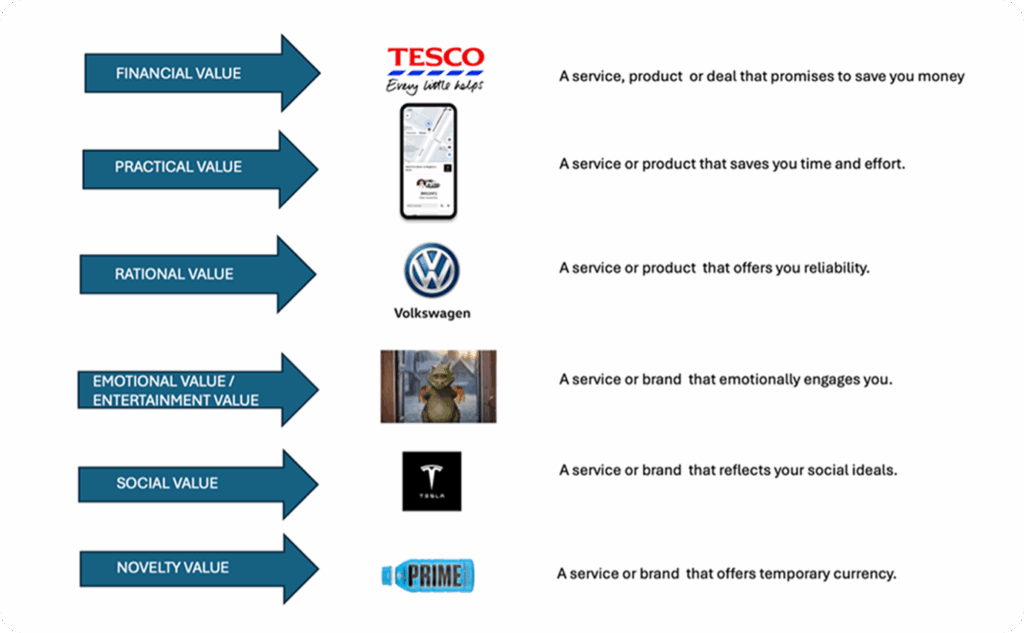Let’s keep up the good work by staying on top of the latest opportunities in marketing.
So, no more rambling! Just carefully distilled insights on these three key topics: brand positioning, creativity and value in advertising, and the power of humour.

INSIGHT 1
Brand Positioning: Why Most Fail and What KitKat Gets Right

Brand positioning should be a growth driver, yet most of it is bland, overcomplicated, or ineffective. As Patagonia’s Yvon Chouinard put it, “If you’re not pissing off 50% of the people, you’re not trying hard enough.” Strong brands don’t just exist—they challenge, excite, and stand for something real.
But as Mark Ritson’s Double D Marketing concept highlights, positioning doesn’t have to be radically unique—it has to be focused. KitKat, for example, has dominated its category by mastering both distinctiveness and differentiation with one clear idea: breaks are good for you.
What works?
- Start with a vision, not just a description – Positioning should define where the brand is going, not just summarize what it is today. If it doesn’t drive meaningful change, it’s just words.
- Keep it tight and focused – Overcomplicated frameworks dilute impact. A brand should be built around one clear idea, not a clutter of values, missions, and personality traits.
- Make it actionable and enable creativity – Positioning should guide execution, not just live in a PowerPoint. It should inspire bold creative work—ask: What would this look like on a product? On a website? On a beer mat?
- Distinctiveness makes you recognizable – Logos, colors, slogans, and brand codes should instantly trigger recognition. Without distinctiveness, positioning won’t stick.
- Own an idea, not the category – Brands don’t need to be unique, just more strongly associated with a key idea than competitors. KitKat owns the concept of breaks better than any other brand.
- Embrace the extremes – The best brands polarize and excite. They’re designed for the most passionate, demanding audiences, not the average consumer.
- Stay consistent over time – KitKat hasn’t radically changed its brand in 50+ years, proving that reinforcing positioning consistently builds strong consumer associations.
The takeaway for marketers
Most brands play it too safe or overcomplicate positioning into meaninglessness. The strongest brands are bold, distinctive, and relentless in reinforcing their positioning. Does your brand have a real positioning—or just a PowerPoint full of buzzwords?
Read More
- Baron Sauvage: Brand positioning: avoiding the average »
- Marketing Week: Copy KitKat on your quest for ‘double D marketing’ »
INSIGHT 2
Creativity, Value, and the Future of Advertising

As the legendary Shaun McIlrath argued in Has Adland Missed Its Blockbuster Moment?, advertising’s biggest challenge isn’t visibility—it’s value. Consumers don’t just want brands to entertain them; they expect real, tangible value across every interaction.
Bain & Company’s 30 Elements of Value framework shows how brands can build relevance by delivering Functional, Emotional, Life-Changing, and Social Impact value. At IVALO, this is one of the frameworks we use in brand strategy and positioning projects, helping brands create meaningful differentiation. The strongest brands don’t just sell products—they craft experiences that resonate on multiple levels.
They have also developed a similar framework for B2B companies, proving that value-driven strategies are just as crucial in business markets as they are in consumer branding.
What works?
- Redefine creativity: Creativity isn’t just about advertising—it’s about designing experiences that add real consumer value, whether through ease (practical value), trust (rational value), or belonging (social value).
- Move from extraction to creation: The most successful brands—like Tesla, Volkswagen, and Prime—don’t just market a product; they shape perceptions, emotions, and culture through innovation.
- Make value shareable: When brands create something worth talking about, consumers become their biggest advocates. As McIlrath highlights, “Value is viral—it travels without a media budget.”
The takeaway for marketers
Creativity must evolve beyond traditional advertising. Brands that prioritize value-driven experiences—instead of just selling—will lead the next era of marketing. Is your brand offering value that consumers truly care about?
Read more
- Harvard Business Review: The Elements of Value »
- WARC: Has Adland missed its blockbuster moment? Creativity is crucial, but so is its definition »
INSIGHT 3
The Power of Humour in Advertising

Humour in advertising has declined 37 % over the past 20 years, yet it remains one of the most effective tools for recall, engagement, and brand success. Recently, discussions around humour’s role in making brands more memorable and human have resurged. The question isn’t whether it works—it’s whether brands dare to use it.
In Finland, humour is dry, self-deprecating, and understated, making it a natural fit for authentic, relatable branding. Done well, subtle wit and irony cut through the noise, resonating with audiences who prefer clever understatement over loud punchlines.
WARC’s report What’s Working in Humorous Advertising highlights how brands like Snickers, Specsavers, and Liquid Death use humour to break through clutter and leave a lasting impact.
What works?
- Humour as a memory hook: Neuroscience shows that humour triggers the brain’s reward system, making ads more memorable and increasing consumer recall.
- Relatability is key: Universal insights—like Snickers’ “You’re not you when you’re hungry”—resonate across cultures and markets, ensuring broad appeal.
- Celebrity + humour drives fame: Pairing humour with well-matched celebrities, like Rick Astley for Specsavers, amplifies reach and boosts social sharing.
- The commercial case for comedy: Humour isn’t just creative—it’s strategic. Ads with humour are 6.1x more effective at driving market share growth than neutral or serious ads.
The takeaway for marketers
Humour isn’t just about making people laugh—it’s a shortcut to likability, engagement, and sales. With audiences growing tired of overly polished, formulaic ads, brands that embrace humour—especially in a way that feels natural to their culture—can stand out, entertain, and build emotional connections that drive long-term loyalty. So, is your brand playing it too safe—or are you ready to unlock the power of humour?
